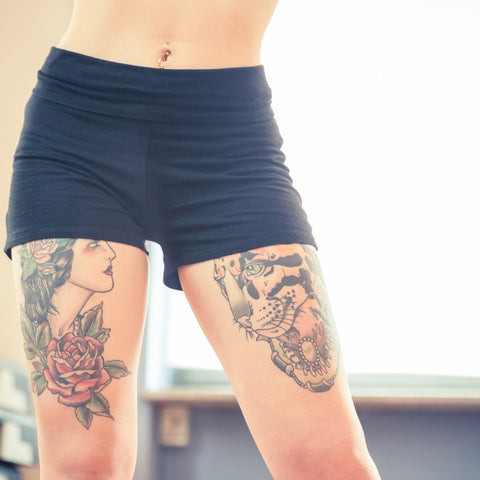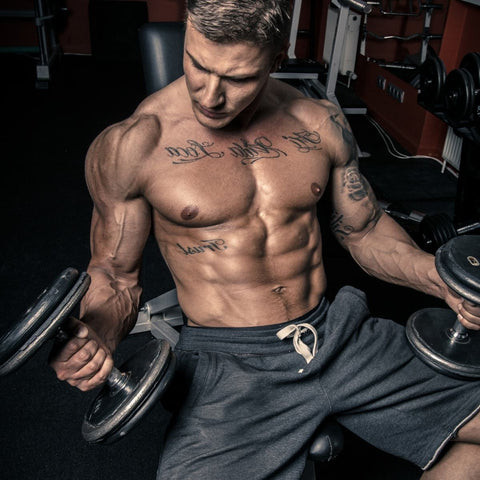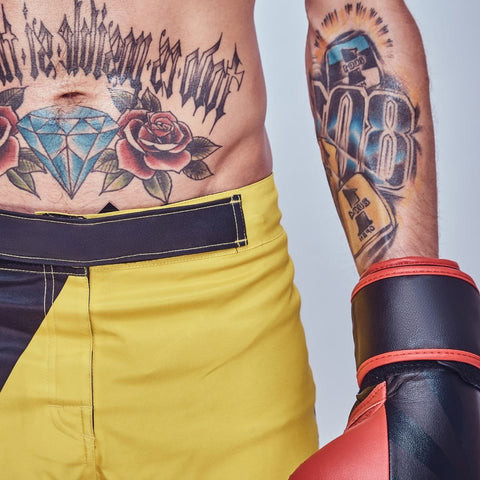Can you workout after getting a tattoo, and how soon is too soon to hit the gym? This article is your ultimate guide, brought to you by tattooat.com, to navigating the world of fitness and fresh ink, ensuring your body art heals beautifully without compromising your workout routine. Keep reading to discover when you can safely return to your favorite activities and how to protect your new tattoo!
1. General Guidelines for Exercising After Getting a Tattoo
Before diving into specific activities, let’s establish some general rules. These guidelines apply to all sports and workout routines, and should be followed until your new tattoo is completely healed.
- Avoid Friction: Refrain from wearing tight clothing or gear that rubs against your new tattoo, especially during the first week.
- Keep it Clean: Always ensure your tattoo remains clean during workouts to prevent infection.
- Minimize Stretching: Excessive stretching of the tattooed skin can hinder the healing process.
- Listen to Your Body: If you experience significant pain, discontinue the activity and rest.
- Follow Aftercare Instructions: Adhere to your tattoo artist’s aftercare guidelines meticulously.
Following these initial steps is crucial to ensuring your ink heals properly and you can get back to your routine as fast as possible.
2. Cardio Workouts and New Tattoos: What’s Safe?
You can typically resume cardio workouts the day after getting a tattoo. Here’s how to make sure you’re doing it safely:
- Clothing: Wear loose clothing that doesn’t rub against the tattooed area.
- Hygiene: Shower immediately after your workout and follow your tattoo aftercare routine.
- Gym Etiquette: Sanitize workout machines before and after use.
- Protection: Cover your tattoo in public gyms to avoid contact with other people’s fluids.
By following these steps, you can maintain your cardio routine without compromising the healing of your new tattoo.
 Cardio workout after tattoo, showing a person on a treadmill with a covered arm tattoo
Cardio workout after tattoo, showing a person on a treadmill with a covered arm tattoo
3. HIIT (High-Intensity Interval Training) with a Fresh Tattoo
Like cardio, HIIT workouts can be resumed the day after getting inked, but with a few adjustments:
- Rest Day: Give your body a day to recover from the tattooing process before engaging in intense exercise.
- Attire: Avoid tight clothing that rubs against the tattooed area during high-intensity movements.
- Cleanliness: Shower post-workout and thoroughly clean any equipment used.
- Coverage: Keep your tattoo covered in public spaces to protect it from germs and other people’s fluids.
4. CrossFit After a Tattoo: Modifying Your Routine
CrossFit enthusiasts can return to their routines the day after getting a tattoo, with some precautions:
- Immediate Pause: Wait until the next day to allow your body to recover from the tattoo process before resuming intense workouts.
- Clothing: Wear comfortable, loose-fitting clothing to avoid rubbing and irritation.
- Movement: Modify exercises to avoid direct contact or friction on the tattooed area.
- Hygiene: Maintain cleanliness by showering after each workout and sanitizing equipment.
5. Weightlifting and Bodybuilding After Getting a Tattoo
Weightlifting and bodybuilding are generally safe to resume the day after getting a tattoo, provided you take certain precautions:
- Adjust Your Routine: Modify your workout to avoid direct pressure or friction on the tattooed area.
- Hygiene: Wipe down equipment before and after use to prevent infection.
- Coverage: Keep the tattoo covered with loose clothing during workouts.
 Weightlifting workout after tattoo, featuring someone lifting weights with a shoulder tattoo covered
Weightlifting workout after tattoo, featuring someone lifting weights with a shoulder tattoo covered
6. Yoga and Stretching: Flexibility with New Ink
Yoga and stretching can be resumed the day after getting a tattoo, but with considerations for the tattoo’s location:
- Avoid Over-Stretching: Be mindful not to over-stretch the skin around the tattooed area.
- Clothing: Wear loose-fitting clothing to prevent rubbing or irritation.
- Hygiene: Shower after workouts, especially hot yoga, and sanitize shared equipment.
7. Swimming After a Tattoo: A Different Approach
Swimming poses a greater risk than other forms of exercise. It’s recommended to wait at least two weeks, or until the tattoo is fully healed, before swimming.
- Risk of Contamination: Swimming exposes the open wound to chemicals, bacteria, and other contaminants that can cause infection and damage the tattoo.
- Complete Healing: Ensure the tattoo is fully healed to prevent complications.
8. Sport-Specific Workouts: Training Smart
Resuming sport-specific workouts is usually safe the day after getting a tattoo, but with some adjustments:
- Contact Sports: Avoid activities that could cause direct contact or trauma to the tattoo.
- Friction: Ensure clothing and gear don’t rub against the tattoo during training.
- Coverage: Keep the tattoo covered and clean equipment thoroughly.
 Sports specific workout after tattoo, featuring an athlete running on a track with a leg tattoo covered
Sports specific workout after tattoo, featuring an athlete running on a track with a leg tattoo covered
9. Understanding the Healing Process
The healing timeline of a new tattoo depends on various factors, including:
- Individual Healing Rate: Everyone heals at different rates.
- Tattoo Size and Location: Larger tattoos and those in high-friction areas may take longer to heal.
- Aftercare Compliance: Following aftercare instructions diligently is crucial for optimal healing.
Generally, a tattoo takes about 2 to 4 weeks to heal on the surface, but complete healing can take several months.
10. Essential Tattoo Aftercare for Active Individuals
Proper aftercare is vital, especially for those who workout regularly:
- Keep it Clean: Gently wash the tattoo with mild, fragrance-free soap and water.
- Moisturize: Apply a thin layer of fragrance-free moisturizer to keep the skin hydrated.
- Avoid Sun Exposure: Protect the tattoo from direct sunlight to prevent fading.
- Stay Hydrated: Drink plenty of water to promote skin health and healing.
- Avoid Picking: Resist the urge to pick or scratch the tattoo, as this can lead to infection and scarring.
11. How Sweat Affects New Tattoos
Sweat itself doesn’t directly harm a new tattoo, but it can create an environment conducive to bacteria growth. Always shower and clean the tattooed area after sweating.
12. Choosing the Right Tattoo Placement for Athletes
Consider the placement of your tattoo if you’re an athlete:
- Minimize Friction: Choose areas that experience minimal friction from clothing or equipment.
- Avoid High-Impact Zones: Steer clear of areas prone to impact or injury during your sport or activity.
- Consider Flexibility: Ensure the tattoo doesn’t impede your range of motion or flexibility.
13. Signs of Tattoo Infection and What to Do
Recognize the signs of a tattoo infection:
- Excessive Redness or Swelling
- Pus or Drainage
- Fever or Chills
- Increased Pain or Tenderness
If you suspect an infection, seek medical attention immediately.
14. Tattoo-Friendly Workout Gear and Clothing
Select workout gear that minimizes friction and allows the skin to breathe:
- Loose-Fitting Clothing
- Breathable Fabrics
- Protective Sleeves or Wraps
15. The Role of Diet and Hydration in Tattoo Healing
Proper nutrition and hydration are essential for overall skin health and tattoo healing:
- Protein-Rich Foods: Support tissue repair and growth.
- Vitamin-Rich Foods: Promote collagen production and immune function.
- Plenty of Water: Keep the skin hydrated and promote circulation.
16. Expert Tattoo Artists on Balancing Ink and Exercise
According to a July 2025 study from Portland State University’s Art Department, the key is balance. Top tattoo artists emphasize the importance of communication between clients and artists regarding lifestyle and workout habits. This helps in determining the best placement and aftercare strategies for active individuals.
17. Debunking Common Myths About Working Out with New Tattoos
Let’s clear up some misconceptions:
- Myth: You can’t workout at all after getting a tattoo.
- Fact: You can workout, but you need to take precautions.
- Myth: Sweat will ruin your tattoo.
- Fact: Sweat itself is not harmful, but it can create a breeding ground for bacteria if not cleaned properly.
- Myth: You need to re-wrap your tattoo every time you workout.
- Fact: Keeping it covered with loose clothing is usually sufficient.
18. Real-Life Experiences: Athletes and Their Tattoos
Many athletes successfully balance their training with their love for tattoos. By following proper aftercare and making necessary adjustments to their routines, they ensure their ink heals beautifully without compromising their performance.
19. Planning Your Tattoo Session Around Your Training Schedule
Consider scheduling your tattoo session during a rest week or off-season to minimize disruption to your training. This allows your body ample time to recover and your tattoo to heal properly.
20. The Psychological Impact of Tattoos on Athletes
Tattoos can have a positive psychological impact on athletes, serving as a form of self-expression, motivation, or commemoration. They can boost confidence and create a sense of identity and belonging.
21. How to Choose a Tattoo Artist Who Understands Active Lifestyles
Select a tattoo artist who is knowledgeable about active lifestyles and the specific challenges they pose to tattoo healing. Look for artists with experience tattooing athletes and a willingness to provide tailored aftercare advice.
22. Tattoo Styles and Their Suitability for Active Individuals
Certain tattoo styles may be more suitable for active individuals:
- Minimalist Designs: Less surface area may result in faster healing.
- Bold, Simple Designs: These tend to hold up better over time with sun exposure and wear.
- Avoid Intricate Details: Detailed designs may fade or blur more easily with sweat and friction.
23. Budgeting for Tattoos and Workout Gear
Factor in the cost of tattoos, aftercare products, and tattoo-friendly workout gear when planning your budget. Prioritize quality aftercare to protect your investment and ensure optimal healing.
24. Traveling with a New Tattoo: Tips for Active Travelers
If you’re traveling with a new tattoo:
- Keep it Clean: Wash the tattoo regularly with mild soap and water.
- Moisturize: Apply a fragrance-free moisturizer to prevent dryness.
- Protect from Sun: Use sunscreen or wear protective clothing.
- Avoid Public Pools and Hot Tubs: These can increase the risk of infection.
25. The Future of Tattoos in the Fitness World
As tattoos become increasingly mainstream, expect to see more innovations in aftercare products, tattoo-friendly workout gear, and techniques that cater to active lifestyles.
26. The Relationship Between Tattoos and Body Image in Sports
Tattoos can play a significant role in shaping body image and self-perception in sports. They can serve as symbols of strength, resilience, and personal identity, empowering athletes to embrace their bodies and express themselves authentically.
27. Tattoo Removal Considerations for Athletes
If you’re considering tattoo removal, be aware that the process can impact your training:
- Laser Tattoo Removal: Requires multiple sessions and can cause temporary skin sensitivity.
- Surgical Excision: May result in scarring and require downtime for healing.
Consult with a dermatologist or tattoo removal specialist to determine the best option for your situation.
28. The Cultural Significance of Tattoos in Different Sports
Tattoos hold different cultural meanings in various sports:
- Indigenous Sports: Tattoos may represent tribal affiliation, spiritual beliefs, or achievements.
- Martial Arts: Tattoos can symbolize discipline, strength, and respect.
- Extreme Sports: Tattoos may signify risk-taking, adventure, and individuality.
29. How to Protect Your Tattoos During Outdoor Workouts
When exercising outdoors:
- Apply Sunscreen: Use a broad-spectrum sunscreen with a high SPF to prevent fading.
- Wear Protective Clothing: Cover the tattoo with loose-fitting clothing or a UV-protective sleeve.
- Stay Hydrated: Drink plenty of water to maintain skin health.
30. The Impact of Tattoos on Professional Athletes’ Careers
While tattoos are generally accepted in professional sports, some athletes may face scrutiny or restrictions based on team policies or sponsorship agreements. Consider the potential impact on your career before getting visible tattoos.
31. Tattoo Cover-Ups: Transforming Old Ink for a New Active You
If you have an old tattoo that no longer aligns with your lifestyle or aesthetic, consider a cover-up. Consult with a skilled tattoo artist to discuss your options and create a new design that complements your active lifestyle.
32. The Ethics of Tattooing Athletes
Tattoo artists have an ethical responsibility to educate athletes about the potential risks and challenges of tattooing, as well as the importance of proper aftercare. They should also respect athletes’ decisions regarding tattoo placement and design.
33. Staying Updated on the Latest Tattoo Aftercare Products
New and improved tattoo aftercare products are constantly emerging. Stay informed about the latest innovations by:
- Reading Reviews
- Consulting with Your Tattoo Artist
- Following Tattoo Industry Blogs and Forums
34. Addressing Concerns About Tattoo Pain and Recovery
If you’re concerned about tattoo pain and recovery:
- Choose a Reputable Artist: Experienced artists can minimize pain and ensure proper healing.
- Use Numbing Creams: Topical numbing creams can help reduce pain during the tattooing process.
- Follow Aftercare Instructions: Proper aftercare is crucial for minimizing discomfort and promoting healing.
35. Finding Inspiration for Tattoo Designs That Reflect Your Sport
Look for inspiration in your sport:
- Team Logos
- Mascots
- Motivational Quotes
- Images of Your Sport in Action
36. The Importance of Open Communication with Your Tattoo Artist
Maintain open communication with your tattoo artist throughout the entire process:
- Discuss Your Lifestyle and Workout Habits
- Ask Questions About Aftercare
- Report Any Concerns or Issues
37. Exploring the World of Temporary Tattoos for Active Events
If you want to show off some ink without the commitment, consider temporary tattoos:
- Henna Tattoos
- Airbrush Tattoos
- Custom Temporary Tattoos
38. Navigating Tattoo Policies in Different Sports Organizations
Be aware of tattoo policies in your sport:
- Some Organizations May Have Restrictions on Visible Tattoos
- Check the Rules and Regulations Before Getting Inked
39. The Psychological Benefits of Self-Expression Through Tattoos
Tattoos can provide a sense of empowerment, self-confidence, and personal identity. They can serve as a reminder of personal achievements, values, or beliefs.
40. Ensuring Long-Term Tattoo Vibrancy for Athletes
To keep your tattoos looking vibrant for years to come:
- Protect from Sun Exposure
- Stay Hydrated
- Moisturize Regularly
- Avoid Harsh Chemicals and Abrasives
Ready to explore the world of tattoos and find the perfect design and artist for your active lifestyle? Visit tattooat.com today for inspiration, resources, and expert advice. Discover a vast library of tattoo designs, connect with talented artists, and access detailed guides on tattoo procedures and aftercare. Don’t wait—start your tattoo journey with tattooat.com now! Address: 1825 SW Broadway, Portland, OR 97201, United States. Phone: +1 (503) 725-3000. Website: tattooat.com.
FAQ: Working Out After Getting a Tattoo
1. How long should I wait to workout after getting a tattoo?
You can typically resume light workouts the next day, but avoid swimming and activities that cause excessive friction or stretching for at least two weeks.
2. Can sweat ruin a new tattoo?
Sweat itself won’t ruin a new tattoo, but it can create an environment for bacteria to thrive. Always clean the tattooed area after sweating.
3. What type of clothing should I wear when working out with a new tattoo?
Wear loose-fitting, breathable clothing that doesn’t rub against the tattoo.
4. Can I swim after getting a tattoo?
It’s recommended to wait at least two weeks, or until the tattoo is fully healed, before swimming to avoid infection.
5. How do I protect my tattoo from the sun when working out outdoors?
Apply a broad-spectrum sunscreen with a high SPF or wear protective clothing.
6. What are the signs of a tattoo infection?
Signs include excessive redness, swelling, pus, fever, and increased pain. Seek medical attention if you suspect an infection.
7. Can I lift weights after getting a tattoo?
Yes, but modify your routine to avoid direct pressure or friction on the tattooed area.
8. How important is tattoo aftercare for athletes?
Proper aftercare is crucial for athletes to prevent infection and ensure optimal healing.
9. What should I do if my tattoo hurts when I workout?
Stop the activity and rest. Adjust your training to avoid putting pressure on the tattoo.
10. How do I choose a tattoo artist who understands active lifestyles?
Look for artists with experience tattooing athletes and a willingness to provide tailored aftercare advice.